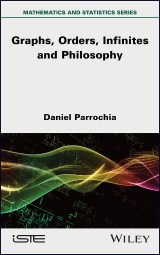Details

Mathematics and Philosophy 2
Graphs, Orders, Infinites and Philosophy1. Aufl.
|
138,99 € |
|
| Verlag: | Wiley |
| Format: | |
| Veröffentl.: | 03.04.2023 |
| ISBN/EAN: | 9781394209361 |
| Sprache: | englisch |
| Anzahl Seiten: | 272 |
DRM-geschütztes eBook, Sie benötigen z.B. Adobe Digital Editions und eine Adobe ID zum Lesen.
Beschreibungen
<p>From Pythagoreans to Hegel, and beyond, this book gives a brief overview of the history of the notion of graphs and introduces the main concepts of graph theory in order to apply them to philosophy. In addition, this book presents how philosophers can use various mathematical notions of order. Throughout the book, philosophical operations and concepts are defined through examining questions relating the two kinds of known infinities – discrete and continuous – and how Woodin's approach can influence elements of philosophy.</p> <p>We also examine how mathematics can help a philosopher to discover the elements of stability which will help to build an image of the world, even if various approaches (for example, negative theology) generally cannot be valid. Finally, we briefly consider the possibilities of weakening formal thought represented by fuzziness and neutrosophic graphs. In a nutshell, this book expresses the importance of graphs when representing ideas and communicating them clearly with others.</p>
<p>Introduction ix</p> <p><b>Chapter 1. Graphs 1</b></p> <p>1.1. Graph theory: a brief history 1</p> <p>1.2. Basic definitions 6</p> <p>1.3. Different types of graphs 6</p> <p>1.4. More on the list of graphs 9</p> <p>1.5. Graphs and vertices 11</p> <p>1.6. Some operations on graphs 13</p> <p>1.7. Graph isomorphisms 15</p> <p>1.7.1. Self-complementary graphs 15</p> <p>1.7.2. Properties of self-complementary graphs 16</p> <p>1.8. Symmetric and asymmetric graphs 17</p> <p>1.9. Extremal graphs 20</p> <p>1.10. Independence, non-separability, reconstruction conjecture 23</p> <p><b>Chapter 2. Philosophical Graphs 29</b></p> <p>2.1. Ancient mappings 29</p> <p>2.2. Chinese tetragrams 33</p> <p>2.3. Pythagorism and pentagram 33</p> <p>2.4. n-grams and some figures of the world 35</p> <p>2.5. Graphs and classical systematicity 41</p> <p>2.6. Towards a new kind of systematicity 52</p> <p>2.6.1. Non-Hamiltonian and non-Eulerian philosophies 52</p> <p>2.6.2. Pancyclic graphs and Metahegelianism 57</p> <p>2.7. Non-pythagorism and arrangement of lines 58</p> <p>2.7.1. Levi graphs of line arrangements 62</p> <p>2.7.2. Line arrangements of curve lines 65</p> <p>2.7.3. Hyperbolic graphs 67</p> <p><b>Chapter 3. Order and Its Philosophical Use 73</b></p> <p>3.1. The mathematical notion of order: a brief history 74</p> <p>3.2. The idea of “well-ordering” 76</p> <p>3.3. Quasiorders (or preorders) 79</p> <p>3.4. Partial orders 81</p> <p>3.4.1. The notion of well partial order 84</p> <p>3.4.2. Linear extension of a poset 84</p> <p>3.4.3. Well partially orderings 85</p> <p>3.5. Trees 85</p> <p>3.5.1. A zoo of infinite trees 86</p> <p>3.5.2. Ordinal infinite classifications 87</p> <p>3.6. Moral problems in a finite world 87</p> <p>3.7. Order versus circularity 92</p> <p>3.8. Conclusion 96</p> <p><b>Chapter 4. Towards a Formal Philosophy 99</b></p> <p>4.1. Asenjo’s systems and Dubarle’s formalization of Hegelianism 99</p> <p>4.1.1. Asenjo’s systems and Dubarle’s case 100</p> <p>4.1.2. Dubarle, Parmenides’ thought and Hegel 102</p> <p>4.1.3. Projective algebras 103</p> <p>4.2. Some criticisms 106</p> <p>4.3. Porphyry and the neoplatonist mode of thought 107</p> <p>4.4. A variant of Dubarle’s formalism 109</p> <p>4.5. Quasi-Hegelian systems 112</p> <p>4.6. Philosophical thinking and finite projective geometry 114</p> <p>4.7. Other algebras for philosophical thinking 116</p> <p>4.8. Models derived from geometry and algebraic geometry 117</p> <p>4.9. Conclusion 120</p> <p><b>Chapter 5. Philosophical Transformations 121</b></p> <p>5.1. The paradox of a metasystem 121</p> <p>5.2. In search of an algebra 137</p> <p><b>Chapter 6. Concepts and Topology 141</b></p> <p>6.1. Formal concepts 141</p> <p>6.2. Fuzzy concepts 143</p> <p>6.3. The case of philosophical concepts 144</p> <p><b>Chapter 7. The Problem of the Infinite 155</b></p> <p>7.1. The arithmetic of infinite cardinals 156</p> <p>7.2. The question of large cardinals 158</p> <p>7.3. Woodin’s program 163</p> <p>7.3.1. Woodin I: CH would be false 163</p> <p>7.3.2. Woodin II: CH may be true 165</p> <p>7.3.3. Ultimate L and CH 167</p> <p>7.4. Infinite and philosophy 167</p> <p><b>Chapter 8. In Search for a New Philosophy 171</b></p> <p>8.1. The finite case 171</p> <p>8.2. The infinite case 176</p> <p><b>Chapter 9. Extension of Structuralism and Negative Theology 181</b></p> <p>9.1. Complementarity graphs 182</p> <p>9.2. Order relation, ordered set 184</p> <p>9.3. Graphs associated with a partially ordered set 185</p> <p>9.4. Complementarity and incomparability graphs of a poset 187</p> <p>9.5. Boolean representation of a poset 187</p> <p>9.6. Case of lattices 189</p> <p>9.6.1. Case of Boolean lattices 191</p> <p>9.6.2. Generalization: Boolean lattices as n-cubes 193</p> <p>9.7. Consequences for negative theology 196</p> <p><b>Chapter 10. From Fuzzy Graphs to Neutrosophic Graphs 201</b></p> <p>10.1. Fuzzy sets 201</p> <p>10.2. Fuzzy graphs 204</p> <p>10.3. Intuitionistic fuzzy set theory 206</p> <p>10.4. Neutrosophy 208</p> <p>10.5. Single-valued neutrosophic sets and graphs 211</p> <p>Conclusion 215</p> <p>References 221</p> <p>Index 235</p>
<p><b>Daniel Parrochia</b> was a research fellow at the French CNRS (National Center for Scientific Research), then a professor at the Universities of Toulouse, Montpellier and Lyon, France. He is the author of thirty books and numerous articles in the field of the philosophy of science.</p>


















